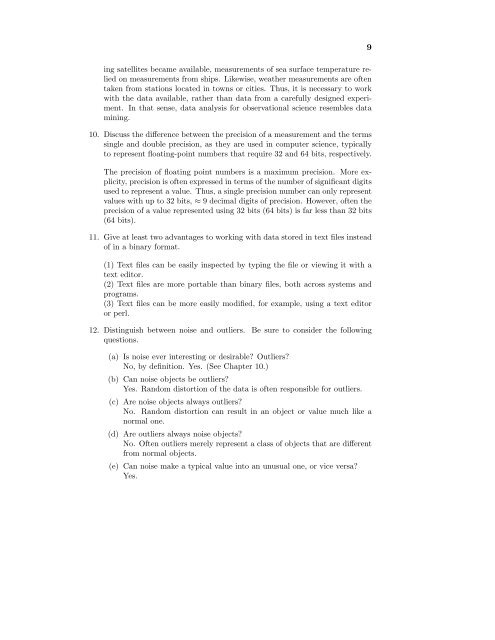Introduction To Data Mining Instructor's Solution Manual
Introduction To Data Mining Instructor's Solution Manual
Introduction To Data Mining Instructor's Solution Manual
Create successful ePaper yourself
Turn your PDF publications into a flip-book with our unique Google optimized e-Paper software.
ing satellites became available, measurements of sea surface temperature relied<br />
on measurements from ships. Likewise, weather measurements are often<br />
taken from stations located in towns or cities. Thus, it is necessary to work<br />
with the data available, rather than data from a carefully designed experiment.<br />
In that sense, data analysis for observational science resembles data<br />
mining.<br />
10. Discuss the difference between the precision of a measurement and the terms<br />
single and double precision, as they are used in computer science, typically<br />
to represent floating-point numbers that require 32 and 64 bits, respectively.<br />
The precision of floating point numbers is a maximum precision. More explicity,<br />
precision is often expressed in terms of the number of significant digits<br />
used to represent a value. Thus, a single precision number can only represent<br />
values with up to 32 bits, ≈ 9 decimal digits of precision. However, often the<br />
precision of a value represented using 32 bits (64 bits) is far less than 32 bits<br />
(64 bits).<br />
11. Give at least two advantages to working with data stored in text files instead<br />
of in a binary format.<br />
(1) Text files can be easily inspected by typing the file or viewing it with a<br />
text editor.<br />
(2) Text files are more portable than binary files, both across systems and<br />
programs.<br />
(3) Text files can be more easily modified, for example, using a text editor<br />
or perl.<br />
12. Distinguish between noise and outliers. Be sure to consider the following<br />
questions.<br />
(a) Is noise ever interesting or desirable? Outliers?<br />
No, by definition. Yes. (See Chapter 10.)<br />
(b) Can noise objects be outliers?<br />
Yes. Random distortion of the data is often responsible for outliers.<br />
(c) Are noise objects always outliers?<br />
No. Random distortion can result in an object or value much like a<br />
normal one.<br />
(d) Are outliers always noise objects?<br />
No. Often outliers merely represent a class of objects that are different<br />
from normal objects.<br />
(e) Can noise make a typical value into an unusual one, or vice versa?<br />
Yes.<br />
9


